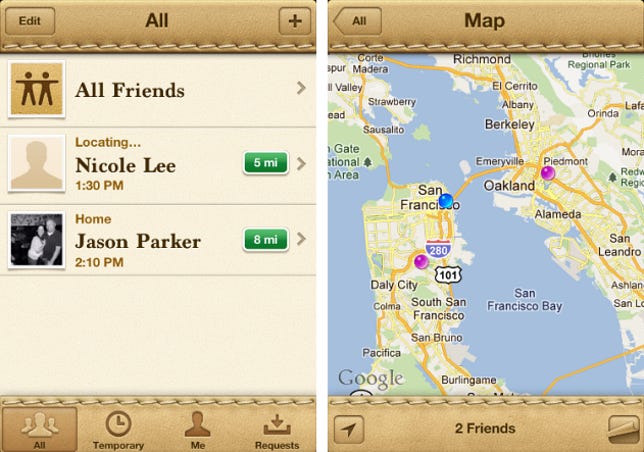Updating software on smartphones has become a scary proposition. It seems like you never know what glitch or bug might break your device.

But at the same time, new software updates promise all kinds of cool new features. And Apple’s iOS 5 is no exception. So it makes sense that iPhone 3GS users, who aren’t ready to upgrade to the iPhone 4S, would want to update their phones with the new software. But can two-and-a half year old iPhone 3GS handle the new software? In this week’s Ask Maggie, I address this very issue.
I also offer some good news to an AT&T smartphone customer about keeping his inexpensive text messaging plan when he upgrades to the iPhone 4S.
Ask Maggie is an advice column that answers readers’ wireless and broadband questions. The column now appears twice a week on CNET, offering readers a double dosage of Ask Maggie’s advice. If you have a question, I’d love to hear from you. Please send me an e-mail at maggie dot reardon at cbs dot com. And please put “Ask Maggie” in the subject header. You can also follow me on Facebook on my Ask Maggie page.
To update or not update?
Dear Maggie,
I have an iPhone 3GS. I’m not eligible for an upgrade until the spring. And then I think I’ll probably get the iPhone 4S. But for now I’ve got to hold onto my 3GS. My question is whether or not I should update my software now to iOS 5 so I can start enjoying some of the new features like iMessage and iCloud. Or should I just not do anything. I know in the past people have had trouble with updates. And I can’t afford to screw up my phone too badly since I still need it for the next six months. What should I do?
Thanks,
James
Dear James
This is a great question. But it’s a tricky one to answer. As you noted, previous iOS upgrades have not gone smoothly for some people who had older hardware. CNET Reviews Mobile section editor Kent German said that when iPhone 3G users first upgraded to iOS 4.0, many noticed the phone slowed down and the new software drained the battery. Some of this was corrected via bug fixes from Apple, but it took a while.


Screenshot by Jessica Dolcourt/CNET
“It was a painful experience for some,” he said.
Apple says that the new iOS 5 software is fine for iPhone 3GS devices. The software has been out less than a week, and there are complaints from some users.The biggest issue I’ve heard from people is regarding battery life. One iPhone 3GS user vents his frustration on an Apple message board:
“Upgraded my 3GS to iOS5 on Wednesday and now it runs out of battery after about 6 hours with no use, 4 hours or less with occasional email use. Had to recharge it 3 times yesterday, and after 4 hours today…Never had these issues until this upgrade.”
And another user said:
“Same for me 4 hours from 100% to 16% with no use iphone 3Gs”
It’s hard to pinpoint the culprit, but people responding on the message board who initially had a similar problem explained that resetting the email and turning off certain functions, such as GPS location services, Bluetooth, push notifications, and iCloud back-up may help fix the problem. Also, if battery life is an issue in general, you may consider reducing the brightness of the screen on your device and turning off Wi-Fi when you’re not at home or near or a Wi-Fi hotspot.
Still, even when you turn off all these options, some people say the OS is still a bit sluggish post iOS 5 upgrade.
That said, the phone is still functional after the upgrade, even if the battery life is diminished and performance is slightly affected. What this means for you is that you have to balance these potential pitfalls with what you’ll be getting in exchange. Keep in mind that that this software update is a big one. The new iOS 5 has more than 200 updates. Some of these new features are not necessarily a big deal. But there are enough enhancements that are worthwhile that you may not want to wait until you upgrade to the iPhone 4S. And unlike the previous iOS update, which actually did not offer too many enhancements for iPhone 3G users, almost all the features in the iOS 5 update will function on the older iPhone 3GS, as well as the newer devices.
You mentioned a couple of these features already in your question. The ones that I think are most interesting are the rejiggered notification screen, which gives you a pull down menu for all your notifications so they are not just popping up on the screen.
I also really like the upgraded camera and photo apps. Now you can pinch the page to zoom in and you can even take a picture by clicking the volume button. You can also edit pictures right on your phone, such as removing red-eye and enhancing the color. While these are not earth shattering enhancements, they’re incremental improvements, which make using the camera on your iPhone a little easier.
I’m also pretty excited about the iMessage function that will allow you to send text messages, photos, videos and contacts to other iOS users on iPhones, iPads or iPhone Touch devices. And I like the wireless syncing for iTunes and the ability to get over-the-air software updates.
If you do decide to upgrade, keep in mind that things can go wrong. And if you’re a few minor updates behind on your device, there’s more of a chance that the software will get hung up when you try to update. That’s why it’s very important that you backup up your iPhone before you begin updating the software. (To do that you simply plug in your phone to iTunes and sync it.) That way, if something goes wrong, you can completely wipe the device and start from scratch. And you’ll be able to reload it with everything you originally had on your phone.
Also, keep in mind that when a big software update like this comes out, app developers will also be releasing new versions of their apps. So you may have to update your apps or even re-download some of them. If it’s an app you paid for already, the App Store will recognize that have already bought the app, and you won’t be forced to pay again.
So what should you do? It really depends on how badly you want these new features. I haven’t heard of iPhone 3GS users having such terrible problems that their phones no longer work. But you may be forced to charge your phone more often. And there may be times when it isn’t as quick. If you can live with these inconveniences, then go for it. Otherwise, you may want to keep things the same and enjoy all the new features when you eventually upgrade to the iPhone 4S. The problem is that once you upgrade, it’s hard to revert back to older versions of the software. It’s not impossible, but it’s not easy.
Good luck.
Are AT&T text messaging plans grandfathered too?
Dear Maggie,
I know AT&T is allowing people with unlimited data plan to keep those plans when they upgrade to the iPhone 4S, but what about the older messaging plans? I signed up with AT&T in 2008 and have the old unlimited data plan that costs $5 a month for 200 messages. I normally use up only 100 to 150 messages a month. I think it was earlier this year that AT&T went to the all or nothing messaging service. Either you don’t get any messaging or you pay $20 for unlimited messaging. If I upgrade to the iPhone 4S, will I also be grandfathered to my old messaging plan? Or will I have to pay an extra $15 a month for the unlimited messaging plan just for the privilege of having an iPhone 4S?
Thanks,
Phil
Dear Phil,
I have some good news for you. I contacted an AT&T representative about your question. And she said that you should be able to keep your $5 text messaging plan that gives you 200 text messages per month when you upgrade to the iPhone 4S. So you won’t have to give up anything.
Just like with the unlimited data plan, this older text messaging plan will be grandfathered in. If you change your cell phone plan and get rid of the $5 deal, you won’t be able to get it back. But if you’re simply upgrading your plan, you should be able to get all the same pricing on these services that you had been getting under your previous contract.
As you pointed out in your question, AT&T eliminated its lower tiers of text messaging in August. So now the $5 a month 200 message plan and the $10 a month 1000 message plan, no longer exist. Instead, new customers are forced to either pay for every incoming and outgoing text, which is 20 cents a pop. Or they can sign up for the unlimited text plan for $20 a month.
It will be interesting to see how the SMS text market evolves if apps like iMessage gain in popularity. iMessage is a feature built into iOS 5, which will allow people to text message, send pictures and videos and share contacts to other people using an Apple product running iOS such as an iPhone, iPad or iPod Touch. The service is free, because it goes over an Internet connection instead of a carrier’s SMS text network.
Microsoft, which bought Internet phone giant Skype and group messaging service GroupMe, is also likely to add messaging features into its Windows Phone software. Research In Motion’s BlackBerry also has a similar service that is very popular, called BlackBerry Messenger. And there are several third party apps that allow people to bypass carrier text messaging.
But wireless operators, which generate more than $20 billion in revenue each year from text messaging, are doing what they can to keep that revenue stream alive. And this is likely why AT&T eliminated the lower tier of text service.
To some degree, customers will be stuck with using some carrier text messaging services because it’s the only messaging service today that doesn’t require a special app and can be used on any cell phone using any software operating system on any carrier network. Apple’s iMessage is limited to Apple devices. And BlackBerry’s BBM service is limited to the BlackBerry. Other third party apps that offer mobile messaging require that users have that app loaded on their phones.



